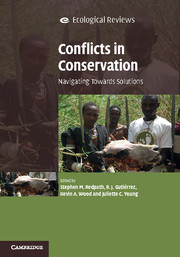Book contents
- Frontmatter
- Dedication
- Contents
- List of contributors
- Foreword by Georgina Mace
- Acknowledgements
- Part I Introduction to conservation and conflict
- PART II Contrasting disciplinary approaches to the study of conflict in conservation
- 3 The value of ecological information in conservation conflict
- 4 Environmental history and conservation conflicts
- 5 The political ecology of conservation conflicts
- 6 Understanding conservation conflicts: an economic perspective
- 7 Anthropological approaches to conservation conflicts
- 8 Law and conservation conflicts
- 9 The relevance of psychology to conservation conflicts
- 10 Conservation conflicts: ethical issues
- 11 A view from sociology: environmental movement mobilisation over old-growth temperate rainforests in British Columbia
- 12 Peace research and conservation conflicts
- 13 Linking conflict and global biodiversity conservation policies
- Part III Approaches to managing conflicts
- Index
- Plate Section
- References
6 - Understanding conservation conflicts: an economic perspective
from PART II - Contrasting disciplinary approaches to the study of conflict in conservation
Published online by Cambridge University Press: 05 May 2015
- Frontmatter
- Dedication
- Contents
- List of contributors
- Foreword by Georgina Mace
- Acknowledgements
- Part I Introduction to conservation and conflict
- PART II Contrasting disciplinary approaches to the study of conflict in conservation
- 3 The value of ecological information in conservation conflict
- 4 Environmental history and conservation conflicts
- 5 The political ecology of conservation conflicts
- 6 Understanding conservation conflicts: an economic perspective
- 7 Anthropological approaches to conservation conflicts
- 8 Law and conservation conflicts
- 9 The relevance of psychology to conservation conflicts
- 10 Conservation conflicts: ethical issues
- 11 A view from sociology: environmental movement mobilisation over old-growth temperate rainforests in British Columbia
- 12 Peace research and conservation conflicts
- 13 Linking conflict and global biodiversity conservation policies
- Part III Approaches to managing conflicts
- Index
- Plate Section
- References
Summary
Economics is concerned with understanding human behaviour and with analysing the consequences of the interactions between economic ‘agents’, be they firms, consumers, bird watchers or trade unions. As a field of study, it is interested in modelling how agents respond to changes in incentives, and how institutions like markets and firms help us manage competing wants given our limited resources. Economics has developed a body of theory and empirical methods which can be applied to analyse the consequences of policy-making on both individual and social well-being. As such, it offers an interesting insight into conflicts. Economics can help us understand why conservation conflicts occur, through measuring the benefits and costs to different parties, and showing how identification of these values can help mitigate conflicts by determining appropriate compensation for losses. Here, I describe the potential contributions that economics can make to conflict management before presenting two case studies to provide some illustration.
Understanding why conservation conflicts occur
Economists would point to three interrelated issues that help explain why conservation conflicts occur. These are incentives, property rights and market failures.
Incentives
Sporting estate managers in Scotland, farmers in African villages and forest owners in Malaysia all respond to incentives of various types. Profit incentives can drive land uses which are detrimental to conservation interests. For example, changes in the price of different outputs from land, such as timber and corn, alter the production plans of farmers, increasing deforestation in Central America (Barbier and Burgess, 1996). Increases in ivory prices heighten incentives for elephant poaching in Kenya, while rising bushmeat prices can encourage local people to allocate more time to illegal hunting in the Serengeti (Campbell et al., 2001). Profits from palm oil production increase forest clearance for replanting with palm oil trees, with consequent negative effects on biodiversity in peat swamps in SE Asia (Jaenicke et al., 2008). High prices for agricultural crops under the Common Agricultural Policy in the 1970s and 1980s drove intensification of land management in Europe, with resultant losses in farmland species and landscape quality (Bowers and Cheshire, 1983).
Changes to incentives can also produce beneficial actions to conservation.
- Type
- Chapter
- Information
- Conflicts in ConservationNavigating Towards Solutions, pp. 79 - 93Publisher: Cambridge University PressPrint publication year: 2015
References
- 1
- Cited by



